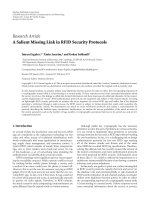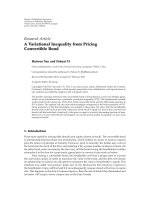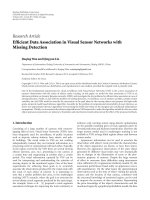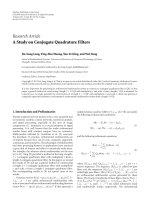Báo cáo hóa học: " Research Article A Hilbert-Type Integral Inequality in the Whole Plane with the Homogeneous Kernel of Degree −2 Dongmei Xin and Bicheng Yang" pdf
Bạn đang xem bản rút gọn của tài liệu. Xem và tải ngay bản đầy đủ của tài liệu tại đây (491.56 KB, 11 trang )
Hindawi Publishing Corporation
Journal of Inequalities and Applications
Volume 2011, Article ID 401428, 11 pages
doi:10.1155/2011/401428
Research Article
A Hilbert-Type Integral Inequality in the Whole
Plane with the Homogeneous Kernel of Degree −2
Dongmei Xin and Bicheng Yang
Department of Mathematics, Guangdong Education Institute, Guangzhou, Guangdong 510303, China
Correspondence should be addressed to Dongmei Xin,
Received 20 December 2010; Accepted 29 January 2011
Academic Editor: S. Al-Homidan
Copyright q 2011 D. Xin and B. Yang. This is an open access article distributed under the Creative
Commons Attribution License, which permits unrestricted use, distribution, and reproduction in
any m edium, provided the original work is properly cited.
By applying the way of real and complex analysis and estimating the weight functions, we build
a new Hilbert-type integral inequality in the whole plane with the homogeneous kernel of degree
−2 involving some parameters and the best constant factor. We also consider its reverse. The
equivalent forms and some particular cases are obtained.
1. Introduction
If fx,gx ≥ 0, satisfying 0 <
∞
0
f
2
xdx < ∞ and 0 <
∞
0
g
2
xdx < ∞,thenwehavesee
1
∞
0
f
x
g
y
x y
dx dy < π
∞
0
f
2
x
dx
∞
0
g
2
x
dx
1/2
,
1.1
where the constant factor π is the best possible. Inequality 1.1 is well known as Hilbert’s
integral inequality, which is important in analysis and in its applications 1, 2. In recent
years, by using the way of weight functions, a number of extensions of 1.1 were given
by Yang 3. Noticing that inequality 1.1 is a Homogenous kernel of degree −1, in 2009,
a survey of the study of Hilbert-type inequalities with the homogeneous kernels of degree
negative numbers and some parameters is given by 4. Recently, some inequalities with the
homogenous kernels of degree 0 and nonhomogenous kernels have been studied see 5–9.
2 Journal of Inequalities and Applications
All of the above inequalities are built in the quarter plane. Yang 10 built a new Hilbert-type
integral inequality in the whole plane as follows:
∞
−∞
f
x
g
y
1 e
xy
dx dy < π
∞
−∞
e
−x
f
2
x
dx
∞
−∞
e
−x
g
2
x
1/2
,
1.2
where the constant factor π is the best possible. Zeng and Xie 11 also give a new inequality
in the whole plane.
By applying the method of 10, 11 and using the way of real and complex analysis,
the main objective of this paper is to give a new Hilbert-type integral inequality in the whole
plane with the homogeneous kernel of degree −2 involving some parameters and a best
constant factor. The reverse form i s considered. As applications, we also obtain the equivalent
forms and some particular cases.
2. Some Lemmas
Lemma 2.1. If |λ| < 1, 0 <α
1
<α
2
<π, define the weight functions ωx and yx, y ∈
−∞, ∞ as follow:
ω
x
:
∞
−∞
min
i∈
{
1,2
}
1
x
2
2xy cos α
i
y
2
|
x
|
1λ
y
λ
dy,
y
:
∞
−∞
min
i∈
{
1,2
}
1
x
2
2xy cos α
i
y
2
y
1−λ
|
x
|
−λ
dx.
2.1
Then we have ωxykλx, y
/
0,where
k
λ
:
π
sin λπ
sin λα
1
sin α
1
sin λ
π −α
2
sin α
2
0 <
|
λ
|
< 1
;
k
0
: lim
λ →0
k
λ
α
1
sin α
1
π − α
2
sin α
2
.
2.2
Proof. For x ∈ −∞, 0, setting u y/x, u −y/x, respectively, in the following first and
second integrals, we have
ω
x
0
−∞
1
x
2
2xy cos α
1
y
2
·
−x
1λ
−y
λ
dy
∞
0
1
x
2
2xy cos α
2
y
2
·
−x
1λ
y
λ
dy
∞
0
u
−λ
u
2
2u cos α
1
1
du
∞
0
u
−λ
u
2
− 2u cos α
2
1
du.
2.3
Journal of Inequalities and Applications 3
Setting a complex function as fz1/z
2
2z cos α
1
1,wherez
1
−e
iα
1
and z
2
−e
−iα
1
are the first-order poles of fz,andz ∞ is the first-order zero point of fz,inviewofthe
theorem of obtaining real integral by residue 12, it follows for 0 < |λ| < 1that
∞
0
u
−λ
du
u
2
2u cos α
1
1
∞
0
u
1−λ−1
du
u
2
2u cos α
1
1
2πi
1 − e
2π1−λi
Re s
z
−λ
f
z
,z
1
Re s
z
−λ
f
z
,z
2
2πi
1 − e
2π1−λi
z
−λ
1
z
1
− z
2
z
−λ
2
z
2
− z
1
−π ·
−1
−λ
sin π
1 −λ
·
−1
1−λ
cos
−λ
α
1
i sin
−λ
α
1
−2i sin α
1
cos λα
1
i sin λα
1
2i sin α
1
π sin λα
1
sin πλsin α
1
.
2.4
For λ 0, we can find by the integral formula that
∞
0
1
u
2
2u cos α
1
1
du
α
1
sin α
1
.
2.5
Obviously, we find that for 0 < |λ| < 1,
∞
0
u
−λ
u
2
− 2u cos α
2
1
du
∞
0
u
−λ
u
2
2u cos
π −α
2
1
du
π ·sin λ
π −α
2
sin λπ · sin α
2
;forλ 0,
∞
0
1
u
2
− 2u cos α
2
1
du
π −α
2
sin α
2
.
2.6
Hencewefindωxkλx ∈ −∞, 0.
4 Journal of Inequalities and Applications
For x ∈ 0, ∞, setting u −y/x, u y/x, respectively, in the following first and
second integrals, we have
ω
x
0
−∞
1
x
2
2xy cos α
2
y
2
·
x
1λ
−y
λ
dy
∞
0
1
x
2
2xy cos α
1
y
2
·
x
1λ
y
λ
dy
∞
0
u
−λ
u
2
− 2u cos α
2
1
du
∞
0
u
−λ
u
2
2u cos α
1
1
du k
λ
.
2.7
Bythesameway,westillcanfindthatyωxkλy,x
/
0; |λ| < 1.The
lemma is proved.
Note 1. 1 It is obvious that ω000; 2 If α
1
α
2
α ∈ 0,π, then it follows
that
min
i∈
{
1,2
}
1
x
2
2xy cos α
i
y
2
1
x
2
2xy cos α y
2
,
2.8
and by Lemma 2.1,wecanobtain
y
ω
x
π cos λ
α −π/2
cos
λπ/2
sin α
y, x
/
0
. 2.9
Lemma 2.2. If p>1, 1/p1/q 1, |λ| < 1 , 0 <α
1
<α
2
<π,andfx is a nonnegative measurable
function in −∞, ∞,thenwehave
J :
∞
−∞
y
p1−λ−1
∞
−∞
min
i∈
{
1,2
}
1
x
2
2xy cos α
i
y
2
f
x
dx
p
dy
≤ k
p
λ
∞
−∞
|
x
|
−pλ−1
f
p
x
dx.
2.10
Journal of Inequalities and Applications 5
Proof. By Lemma 2.1 and H
¨
older’s inequality 13,wehave
∞
−∞
min
i∈
{
1,2
}
1
x
2
2xy cos α
i
y
2
f
x
p
∞
−∞
min
i∈
{
1,2
}
1
x
2
2xy cos α
i
y
2
|
x
|
−λ/q
y
λ/p
f
x
y
λ/p
|
x
|
−λ/q
dx
p
≤
∞
−∞
min
i∈
{
1,2
}
1
x
2
2xy cos α
i
y
2
|
x
|
1−pλ
y
λ
f
p
x
dx
×
∞
−∞
min
i∈
{
1,2
}
1
x
2
2xy cos α
i
y
2
y
q−1λ
|
x
|
−λ
dx
p−1
k
p−1
λ
y
pλ−11
∞
−∞
min
i∈
{
1,2
}
1
x
2
2xy cos α
i
y
2
|
x
|
1−pλ
y
λ
f
p
x
dx.
2.11
Then by Fubini theorem, it follows that
J ≤ k
p−1
λ
∞
−∞
∞
−∞
min
i∈
{
1,2
}
1
x
2
2xy cos α
i
y
2
|
x
|
1−pλ
y
λ
f
p
x
dx
dy
k
p−1
λ
∞
−∞
ω
x
|
x
|
−pλ−1
f
p
x
dx
k
p
λ
∞
−∞
|
x
|
−pλ−1
f
p
x
dx.
2.12
The lemma is proved.
3. Main Results and Applications
Theorem 3.1. If p>1, 1/p 1/q 1, |λ| < 1, 0 <α
1
<α
2
< π,f,g ≥ 0, satisfying 0 <
∞
−∞
|x|
−pλ−1
f
p
xdx < ∞ and 0 <
∞
−∞
|y|
qλ−1
g
q
ydy < ∞,thenwehave
I :
∞
−∞
min
i∈
{
1,2
}
1
x
2
2xy cos α
i
y
2
f
x
g
y
dx dy
<k
λ
∞
−∞
|
x
|
−pλ−1
f
p
x
dx
1/p
∞
−∞
y
qλ−1
g
q
y
dy
1/q
,
3.1
6 Journal of Inequalities and Applications
J
∞
−∞
y
p1−λ−1
∞
−∞
min
i∈
{
1,2
}
1
x
2
2xy cos α
i
y
2
f
x
dx
p
dy
<k
p
λ
∞
−∞
|
x
|
−pλ−1
f
p
x
dx,
3.2
where th e constant factor kλ and k
p
λ are the best possible and kλ is defined by Lemma 2.1.
Inequality 3.1 and 3.2 are equivalent.
Proof. If 2.11 takes the form of equality for a y ∈ −∞, 0∪0, ∞, then there exist constants A
and B, such that they are not all zero, and A|x|
1−pλ
/|y|
λ
f
p
xB|y|
q−1λ
/|x|
−λ
g
q
y a.e.
in −∞, 0 ∪ 0, ∞.Hence,thereexistsaconstantC,suchthatA·|x|
−pλ
f
p
xB·|y|
qλ
g
q
y
C a.e. in 0, ∞. We suppose A
/
0 otherwise B A 0.Then|x|
−pλ−1
f
p
xC/A|x| a. e. in
−∞, ∞, which contradicts the fact that 0 <
∞
−∞
|x|
−pλ−1
f
p
xdx < ∞.Hence2.11 takes the
form of strict inequality, so does 2.10, and we have 3.2.
By the H
lder’s inequality 13,wehave
I
∞
−∞
y
1/q−λ
∞
−∞
min
i∈
{
1,2
}
1
x
2
2xy cos α
i
y
2
f
x
dx
y
λ−1/q
g
y
dy
≤ J
1/p
∞
−∞
y
qλ−1
g
q
y
dy
1/q
.
3.3
By 3.2,wehave3.1. On the other hand, suppose that 3.1 is valid. Setting
g
y
y
p1−λ−1
∞
−∞
min
i∈
{
1,2
}
1
x
2
2xy cos α
i
y
2
f
x
dx
p−1
,
3.4
then it follows J
∞
−∞
|y|
qλ−1
g
q
ydy.By2.10,wehaveJ<∞.IfJ 0, then 3.2 is obvious
value; if 0 <J<∞,thenby3.1,weobtain
0 <
∞
−∞
y
qλ−1
g
q
y
dy J I
<k
λ
∞
−∞
|
x
|
−pλ−1
f
p
x
dx
1/p
∞
−∞
y
qλ−1
g
q
y
dy
1/q
,
J
1/p
∞
−∞
y
qλ−1
g
q
y
dy
1/p
<k
λ
∞
−∞
|
x
|
−pλ−1
f
p
x
dx
1/p
.
3.5
Hencewehave3.2, which is equivalent to 3.1.
Journal of Inequalities and Applications 7
For ε>0, define functions
fx, gx as follows:
f
x
:
⎧
⎪
⎪
⎪
⎪
⎪
⎨
⎪
⎪
⎪
⎪
⎪
⎩
x
λ−2ε/p
,x∈
1, ∞
,
0,x∈
−1, 1
,
−x
λ−2ε/p
,x∈
−∞, −1
,
g
x
:
⎧
⎪
⎪
⎪
⎪
⎪
⎨
⎪
⎪
⎪
⎪
⎪
⎩
x
−λ−2ε/q
,x∈
1, ∞
,
0,x∈
−1, 1
,
−x
−λ−2ε/q
,x∈
−∞, −1
.
3.6
Then
L : {
∞
−∞
|x|
−pλ−1
f
p
xdx}
1/p
{
∞
−∞
|y|
qλ−1
g
q
ydy}
1/q
1/ε and
I :
∞
−∞
min
i∈
{
1,2
}
1
x
2
2xy cos α
i
y
2
f
x
g
y
dx dy I
1
I
2
I
3
I
4
,
3.7
where
I
1
:
−1
−∞
−x
λ−2ε/p
−1
−∞
−y
−λ−2ε/q
x
2
2xy cos α
1
y
2
dy
dx,
I
2
:
−1
−∞
−x
λ−2ε/p
∞
1
y
−λ−2ε/q
x
2
2xy cos α
2
y
2
dy
dx,
I
3
:
∞
1
x
λ−2ε/p
−1
−∞
−y
−λ−2ε/q
x
2
2xy cos α
2
y
2
dy
dx,
I
4
:
∞
1
x
λ−2ε/p
∞
1
y
−λ−2ε/q
x
2
2xy cos α
1
y
2
dy
dx.
3.8
By Fubini theorem 14,weobtain
I
1
I
4
∞
1
x
−1−2ε
∞
1/x
u
−λ−2ε/q
u
2
2u cos α
1
1
du
u
y
x
∞
1
x
−1−2ε
1
1/x
u
−λ−2ε/q
du
u
2
2u cos α
1
1
∞
1
u
−λ−2ε/q
du
u
2
2u cos α
1
1
dx
1
0
∞
1/u
x
−1−2ε
dy
u
−λ−2ε/q
du
u
2
2u cos α
1
1
1
2ε
∞
1
u
−λ−2ε/q
du
u
2
2u cos α
1
1
8 Journal of Inequalities and Applications
1
2ε
1
0
u
−λ2ε/p
u
2
2u cos α
1
1
du
∞
1
u
−λ−2ε/q
u
2
2u cos α
1
1
du
,
I
2
I
3
1
2ε
1
0
u
−λ2ε/p
u
2
− 2u cos α
2
1
du
∞
1
u
−λ−2ε/q
u
2
− 2u cos α
2
1
du
.
3.9
In view of the above results, if the constant factor kλ in 3.1 is not the best possible, then
exists a positive number K with K<kλ,suchthat
1
0
u
−λ2ε/p
u
2
2u cos α
1
1
du
∞
1
u
−λ−2ε/q
u
2
2u cos α
1
1
du
1
0
u
−λ2ε/p
du
u
2
− 2u cos α
2
1
∞
1
u
−λ−2ε/q
du
u
2
− 2u cos α
2
1
ε
I<εK
L K.
3.10
By Fatou lemma 14 and 3.10,wehave
k
λ
∞
0
u
−λ
u
2
2u cos α
1
1
du
∞
0
u
−λ
u
2
− 2u cos α
2
1
du
1
0
lim
ε →0
u
−λ2ε/p
u
2
2u cos α
1
1
du
∞
1
lim
ε →0
u
−λ−2ε/q
u
2
2u cos α
1
1
du
1
0
lim
ε →0
u
−λ2ε/p
u
2
− 2u cos α
2
1
du
∞
1
lim
ε →0
u
−λ−2ε/q
u
2
− 2u cos α
2
1
du
≤ lim
ε →0
1
0
u
−λ2ε/p
u
2
2u cos α
1
1
du
∞
1
u
−λ−2ε/q
u
2
2u cos α
1
1
du
1
0
u
−λ2ε/p
u
2
− 2u cos α
2
1
du
∞
1
u
−λ−2ε/q
u
2
− 2u cos α
2
1
du
≤ K,
3.11
which contradicts the fact that K<kλ. Hence the constant factor kλ in 3.1 is the best
possible.
If the constant factor in 3.2 is not the best possible, then by 3.3,wemaygeta
contradiction that the constant factor in 3.1 is not the best possible. Thus the theorem is
proved.
Journal of Inequalities and Applications 9
In view of Note 2 and Theorem 3.1, we still have the following theorem.
Theorem 3.2. If p>1, 1/p 1/q 1, |λ| < 1, 0 <α<π,andf, g ≥ 0, satisfying
0 <
∞
−∞
|x|
−pλ−1
f
p
xdx < ∞ and 0 <
∞
−∞
|y|
qλ−1
g
q
ydy < ∞,thenwehave
∞
−∞
1
x
2
2xy cos α y
2
f
x
g
y
dx dy
<
π cos λ
α −π/2
cos
λπ/2
sin α
∞
−∞
|
x
|
−pλ−1
f
p
x
dx
1/p
∞
−∞
y
qλ−1
g
q
ydy
1/q
,
∞
−∞
y
p1−λ−1
∞
−∞
1
x
2
2xy cos α y
2
f
x
dx
p
dy
<
π cos λ
α −π/2
cos
λπ/2
sin α
p
∞
−∞
|
x
|
−pλ−1
f
p
x
dx,
3.12
where the constant factors π cos λα − π/2/ cosλπ/2 sin α and π cos λα − π/2/
cosλπ/2 sin α
p
are the best possible. Inequality 3.12 is equivalent.
In particular, for α π/3, we have the following equivalent inequalities:
∞
−∞
1
x
2
xy y
2
f
x
g
y
dx dy
<
2π cos
λπ/6
√
3cos
λπ/2
∞
−∞
|
x
|
−pλ−1
f
p
x
dx
1/p
∞
−∞
y
qλ−1
g
q
y
dy
1/q
,
∞
−∞
y
p1−λ−1
∞
−∞
1
x
2
xy y
2
f
x
dx
p
dy
<
2π cos
λπ/6
√
3cos
λπ/2
p
∞
−∞
|
x
|
−pλ−1
f
p
x
dx.
3.13
Theorem 3.3. As the assumptions of Theorem 3 .1,replacingp>1 by 0 <p<1,wehavethe
equivalent reverses of 3.1 and 3.2 with the best constant factors.
Proof. By the reverse H
¨
older’s inequality 13,wehavethereverseof2.10 and 3.3.Itis
easy to obtain the reverse of 3.2.Inviewofthereversesof3.2 and 3.3,weobtainthe
reverse of 3.1. On the other hand, suppose that the reverse of 3.1 is valid. Setting the same
gy as Theorem 3.1,bythereverseof2.10,wehaveJ>0. If J ∞, then the reverse o f 3.2
is obvious value; if J<∞, then by the reverse of 3.1, we obtain the reverses of 3.5.Hence
we have the reverse of 3.2
, which is equivalent to the reverse of 3.1.
10 Journal of Inequalities and Applications
If the constant factor kλ in the reverse of 3.1 is not the best possible, then there
exists a positive constant K with K>kλ, such that the reverse of 3.1 is still valid as we
replace kλ by K.Bythereverseof3.10,wehave
1
0
1
u
2
2u cos α
1
1
1
u
2
− 2u cos α
2
1
u
−λ2ε/p
du
∞
1
1
u
2
2u cos α
1
1
1
u
2
− 2u cos α
2
1
u
−λ−2ε/q
du > K.
3.14
For ε → 0
,bytheLevi’stheorem14,wefind
1
0
1
u
2
2u cos α
1
1
1
u
2
− 2u cos α
2
1
u
−λ2ε/p
du
−→
1
0
1
u
2
2u cos α
1
1
1
u
2
− 2u cos α
2
1
u
−λ
du.
3.15
For 0 <ε<ε
0
, q<0, such that |λ 2ε
0
/q| < 1, since
u
−λ−2ε/q
≤ u
−λ−2ε
0
/q
,u∈
1, ∞
,
∞
1
1
u
2
2u cos α
1
1
1
u
2
− 2u cos α
2
1
u
−λ−2ε
0
/q
du ≤ k
λ
2ε
0
q
< ∞,
3.16
then by Lebesgue control convergence theorem 14,forε → 0
,wehave
∞
1
1
u
2
2u cos α
1
1
1
u
2
− 2u cos α
2
1
u
−λ−2ε/q
du
−→
∞
1
1
u
2
2u cos α
1
1
1
u
2
− 2u cos α
2
1
u
−λ
du.
3.17
By 3.14, 3.15,and3.17,forε → 0
,wehavekλ ≥ K, which contradicts the fact that
kλ <K. Hence the constant factor kλ in the reverse of 3.1 is the best possible.
If the constant f actor in reverse of 3.2 is not the best possible, then by the reverse of
3.3, we may get a contradiction that the constant factor in the reverse of 3.1 is not the best
possible. Thus the theorem is proved.
BythesamewayofTheorem 3.3, we still have the following theorem.
Theorem 3.4. By the assumptions of Theorem 3.2,replacingp>1 by 0 <p<1,wehavethe
equivalent reverses of 3.12 with the best constant factors.
Journal of Inequalities and Applications 11
References
1 G. H. Hardy, J. E. Littlewood, and G. P
´
olya, Inequalities, The University Press, Cambridge, UK, 2nd
edition, 1952.
2 D. S. Mitrinovi
´
c, J. E. Pe
ˇ
cari
´
c,andA.M.Fink,Inequalities Involving Functions and Their Integrals
and Derivatives,vol.53ofMathematics and Its Applications (East European Series),KluwerAcademic
Publishers, D ordr echt, The Netherlands, 1991.
3 B. Yang, The Norm of Operator and Hilbert-Type Inequalities, Science Press, Beijing, China, 2009.
4 B. C. Yang, “A survey of the study of Hilbert-type inequalities with parameters,” Advances in
Mathematics, vol. 38, no. 3, pp. 257–268, 2009.
5 B. C. Yang, “On the norm of an integral operator and applications,” Journal of Mathematical Analysis
and Applications, vol. 321, no. 1, pp. 182–192, 2006.
6 J. Xu, “Hardy-Hilbert’s i nequalities with two parameters,” Advances in Mathematics, vol. 36, no. 2, pp.
189–202, 2007.
7 B. C. Yang, “On the norm of a Hilbert’s type linear operator and applications,” Journal of Mathematical
Analysis and Applications, vol. 325, no. 1, pp. 529–541, 2007.
8 D. M. Xin, “A Hilbert-type integral inequality with a homogeneous kernel o f zero degree,”
Mathematical Theory and Applications, vol. 30, no. 2, pp. 70–74, 2010.
9 B. C. Yang, “A Hilbert-type integral inequality with a homogeneous kernel of degree zero,” Journal of
Shandong University . Natural Science, vol. 45, no. 2, pp. 103–106, 2010.
10 B. C. Yang, “A new Hilbert-type inequality,” Bulletin of the Belgian Mathematical Society, vol. 13, no. 3,
pp. 479–487, 2006.
11 Z. Zeng and Z. Xie, “On a new Hilbert-type integral inequality with the integral in whole plane,”
Journal of I nequalities and Applications, vol. 2010, Article ID 256796, 8 pages, 2010.
12 Y.Ping,H.Wang,andL.SongJr.,Complex Function, Science Press, Beijing, China, 2004.
13 J. Kuang, Applied Inequalities, Shangdong Science and Technology Press, Jinan, China, 2004.
14
J. Kuang, Introudction to Real Analysis, Hunan Educiton Press, Changsha, China, 1996.









